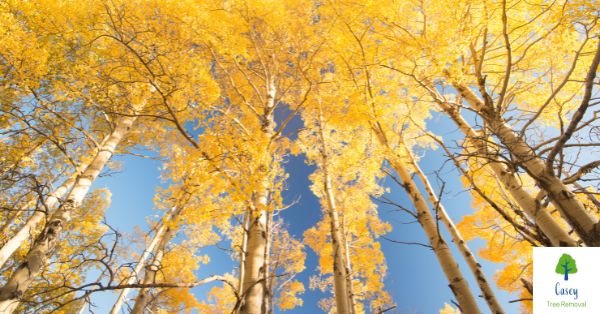Aspen trees are pretty well-known for some great characteristics in home landscapes.
In fact, you might find you’re not sure what this tree is more loved for – its brilliant yellow foliage in autumn, its whitish trunks that stand in bold contrast, or the rustling of its quaking leaves.
Think you have an aspen in your yard or maybe want to add one? Here are some aspen tree facts and types of aspen trees you can try to get the visually appealing contrast they bring to your landscape.
How To Identify An Aspen Tree
The aspen tree has quite a few identifying features that can help distinguish it from other trees.
You might notice its tall, slender appearance, for instance. Also, if you see them in forests, aspens tend to grow in groves rather than as single trees. Aspens often reproduce vegetatively, meaning they send up above-ground shoots from their below-ground roots. So sometimes a single grove of multiple trees is actually clones of the same organism!
They grow between 20 to 80 feet tall and 20 feet wide.
But the leaves and bark of aspens are also quite unique.
Aspen Tree Leaves
Aspen tree leaves are flat and round with pointed tips and serrated edges.
The leaves make a soft, fluttering sound, and even in gentle breezes, the leaves flutter showcasing shiny upper leaves with duller undersides, resembling butterflies.
Aspen Tree Bark
The long, slender whitish trunk of the aspen tree stands out with its black marks, showcasing a distinguished pattern.
The trunk is slender, and the aspen tree bark is thin. At the base of the tree, the bark is coarse, gray, and furrowed, getting smoother and lighter moving up the tree.
Aspen Tree vs. Birch Tree
Aspen and birch trees can be confused quite a bit. In fact, some people will mistake them for the same tree. But they do have some distinct differences.
Certain birch species are well-known for having bark that peels back, similar to paper. Aspen tree bark, on the other hand, does not peel.
Another differentiating characteristic are the leaves. Aspen leaves are flat, wider, and rounder, while birch leaves are slightly V-shaped and more elongated.
Aspen Tree General Characteristics
- Grow zones: Aspen trees grow well in USDA hardiness zones 2 to 8.
- Where to plant: Plant this tree in rich, well-drained soil that can be consistently moist. Avoid planting aspens near buildings since they tend to have a vigorous, invasive root system.
- Height/spread: The aspen tree grows between 20 to 80 feet tall and 20 feet wide.
- Sunlight: This tree grows best in full sun.
- Flowering dates: Aspen catkins elongate before the leaves expand. Catkins appear in mid-March to April with flowering in May to June.
- Best time to prune: Winter – outside of an aspen tree’s active growth cycle – is the best time for pruning.
- Deer resistance: Deer do like to seek shade in aspen groves in summer, and they also can consume the bark, leaves, buds, and twigs throughout the year.
Potential Threats
Some of the biggest threats to aspen are wood and bark boring insects. During their larval stages is when these insects cause the most damage. They are attracted to wounded or weak trees.
cormerly gypsy moth) are also a threat to aspen trees. In April or early May, these insects begin feeding on new leaves. Weak trees are more susceptible to these pests, so fertilizing regularly and eliminating stress may help keep your trees strong.
To keep potential threats from harming your aspen trees, maintain a proper watering schedule since these trees don’t like over- or under-watering. Also, avoid wounding the main trunk with the lawn mower or other equipment, which can attract boring insects.
Casey Tree Removal – All Tree Services including Tree Cutting, Tree mulching, Tree Trimming, Stump Grinding, Tree Pruning, Stump Removal, Emergency Tree Removal Experts In Melbourne!
Click here to read more articles regarding tree removal & related services.
If you are in Bonbeach, and looking for Casey Tree Removal, below is the best way to visit us.


Recent Comments